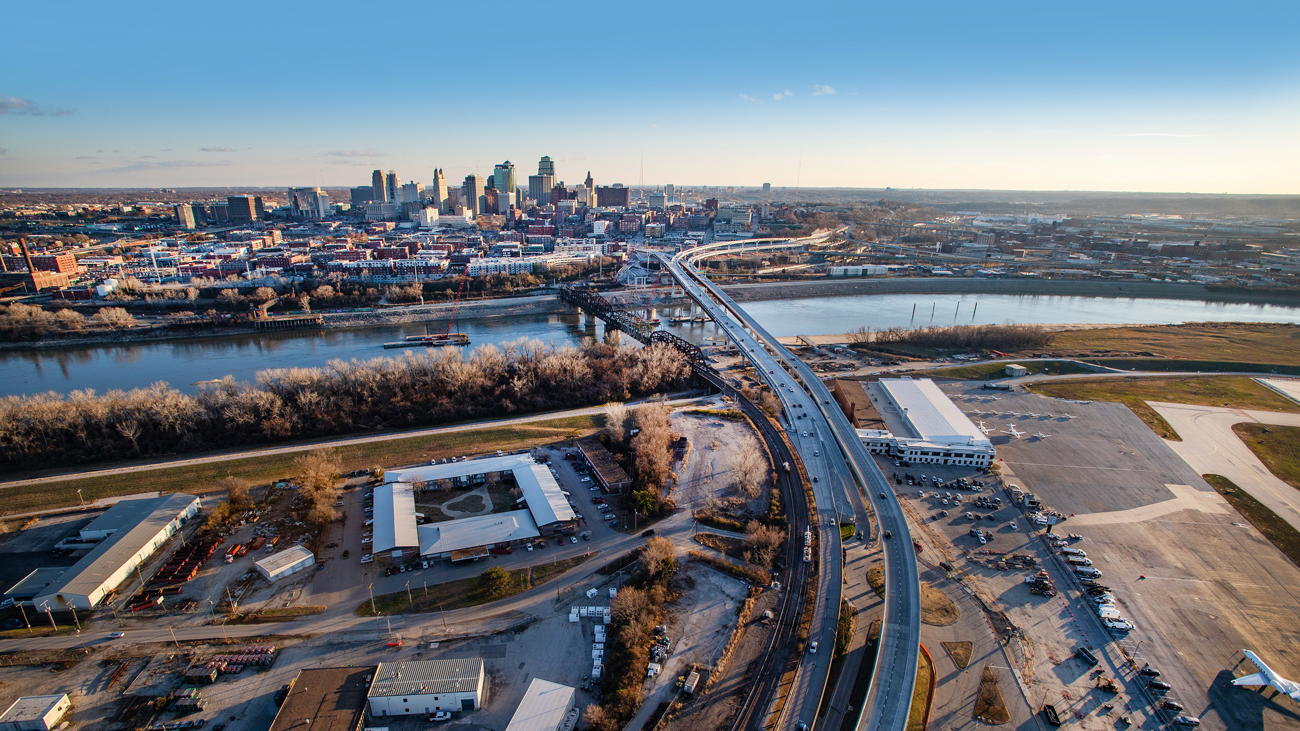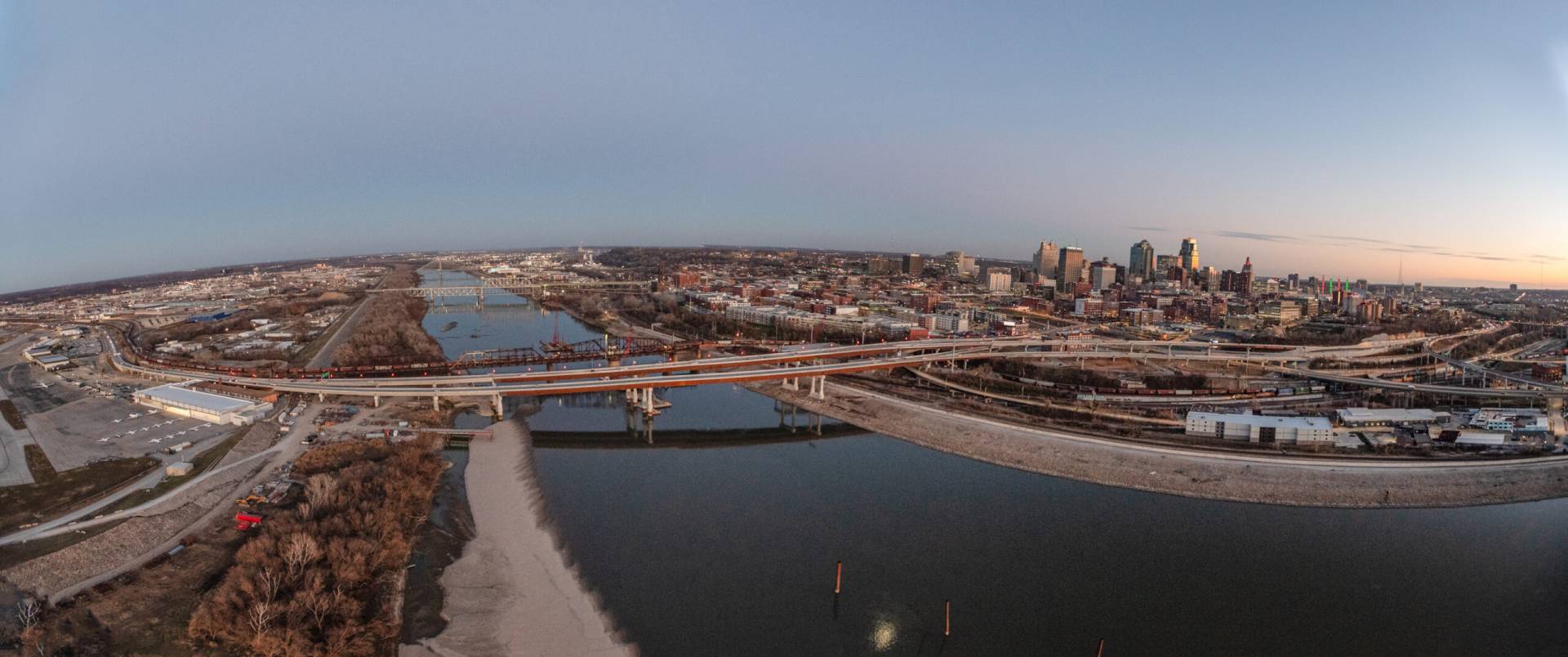
The new Buck O’Neil Bridge in Kansas City, Missouri, improves safety and enhances regional transportation
DESIGNER
2025
Within a few square miles in downtown Kansas City, Missouri, highways, rail lines, a downtown airport and Missouri River barge traffic are woven together in a complex transportation network that moves people and goods throughout the region.
Crossing over this critical corridor is the John Jordan “Buck” O’Neil Memorial Bridge, a new and reimagined structure that replaced the original bridge built in 1956. Carrying U.S. Highway 169 over the Missouri River, the two long-span bridges, owned by the Missouri Department of Transportation (MoDOT), serve both as a gateway into downtown Kansas City and as a key connection between the city’s core and the growing communities north of the river.
“MoDOT set out to deliver a future-ready bridge that would serve the region for the next 100 years with reduced maintenance demands,” said Hans Hutton, HNTB practice consultant. "They also saw the opportunity to enhance safety by adding an ADA-compliant pathway for pedestrians and cyclists."
To meet those goals efficiently and collaboratively, the project was delivered using a design-build method. As the lead designer for the project’s Massman Construction-Clarkson Construction joint venture, HNTB started work on the project in early 2021.
Addressing project complexity in design
“Navigating the constrained footprint and coordinating with numerous stakeholders — utility owners, railroads, the Federal Aviation Administration, the Federal Highway Administration and the Army Corps of Engineers — made this one of the most complex design-build projects MoDOT has ever delivered in the Kansas City area,” said Marc Whitmore, HNTB project manager.
The project encompassed the design and construction of the bridge, which included a dedicated, barrier-separated bicycle/pedestrian walkway and modified access to the airport. It also encompassed eight other bridges, including approach spans and new flyover structures that provide direct access to and from Interstate 35 across the river into downtown Kansas City.
The flyover ramps removed thousands of vehicles from local intersections and reduced drivers’ commutes by approximately five minutes during peak travel hours.
HNTB worked closely with the joint venture team to limit curvature on some of the bridges, allowing them to be designed as prestressed concrete girder spans. This approach eliminated the need for design exceptions by improving sight distance and enhancing project safety.
“Meeting MoDOT’s objectives meant navigating complex requirements — from crossing railroad corridors to ensuring Coast Guard clearances over the Missouri River,” Hutton said. “Our tailored design approach, combining steel plate girders for the main span with prestressed concrete on the flanks, offered a smart solution that respected both technical and stakeholder constraints.”
The twin bridge spans each feature a 1,200-foot steel unit with a 455-foot main navigation span. The bridge segments are founded on 11-foot-diameter, 100-foot-deep drilled shafts designed to resist vessel collision. This approach ensured structural integrity and safety, addressing the challenges posed by the Missouri River’s navigational demands and its constantly changing water level.
On the north end of the bridge, the design team significantly improved a historically challenging curve into a safer, more intuitive route to the Kansas City Downtown Airport. By reconfiguring the interchange — including a longer deceleration lane and enhanced signage — the team preserved access to the airport while greatly improving driver safety and comfort. This innovative solution not only enhanced functionality but also avoided disruption to the adjacent railroad, helping reduce both project costs and overall construction risk. The previous Buck O’Neil steel truss bridge featured three arched main spans, but FAA height restrictions limited the new design’s vertical elements. HNTB developed a streamlined plate girder structure that balances efficiency, cost-effectiveness and long-term durability.
Built to Last a Century
- 10 ksi concrete in bridge’s prestressed girders
- 5 ksi concrete and 75 ksi reinforcing steel in substructure elements
- 7 million pounds of rebar installed
- 21,000 cubic yards of concrete used
- 18 million pounds of structural steel

“The ability to balance the needs of the pedestrians, people who live downtown and the regional commuters is seen in the design and has benefitted all user groups.”
Designing with thoughtfulness and purpose
The Buck O’Neil Bridge is named in honor of the former Kansas City Monarchs’ first baseman and manager. O’Neil, who later became the first Black coach in Major League Baseball and was a longtime scout for the Kansas City Royals, was posthumously inducted into the Baseball Hall of Fame.
The northbound span of the namesake bridge features a midspan scenic overlook equipped with benches and murals celebrating O’Neil’s legacy, where pedestrians and cyclists can reflect on his contributions to baseball while enjoying panoramic river views. The lane also is lined with aesthetic, LED color lighting that highlights the new river bridge and adds to the Kansas City skyline.
On the south side of the bridge, the pedestrian/bike lane ties into the area’s Riverfront Heritage Trail system. Booming development on the riverfront makes the bridge an increasingly important, multimodal conduit for motorists, bicyclists and pedestrians, and there are long-term plans to connect the bridge’s trail to north-side paths as development continues.
A core element of this project was an urban design plan that blends with and enhances the neighborhood’s urban character and quality of life.
“The design team gave special attention to the bridge piers, creating a clean, modern aesthetic by placing the bridge girders on rectangular caps with single rectangular columns that transition into a single shaft buried underground,” Hutton said. “This approach minimized visible footings and maintained a sleek profile. In addition, several pier surfaces were intentionally designed as canvases for local artists, allowing the structure to reflect and celebrate the surrounding community.”
The design included realigning city streets to create more direct routes for freight and local traffic. It supports connectivity and visual character while strengthening public resources, amenities and parks.
“There are many complexities and competing interests between local stakeholders, and so coming up with a design that met all these requirements led to tremendous success for the project,” said James Pflum, project director with the Missouri Department of Transportation. “The ability to balance the needs of the pedestrians, people who live downtown and the regional commuters is seen in the design and has benefitted all user groups.”
The urban design strategies, organized around the theme of “building connections,” offered local artists the opportunity to create semipermanent artwork on a large retaining wall located beneath the bridge. Designed to showcase the creativity and vibrancy of the Kansas City community, the art project reflects the area’s natural and cultural values and continues its public art tradition.
Maintaining transportation during construction
Throughout the years of construction, the Buck O’Neil Bridge was a key conduit for residents and tourists accessing downtown Kansas City. MoDOT’s access goals were straightforward: prepare for extra traffic and keep it moving. The ability to successfully maintain steady traffic flow was put to the test when Kansas City hosted the 2023 NFL Draft, Kansas City Chiefs playoff games and other major events during construction.
To maintain transportation while the bridge was being built, the team fully constructed the new southbound span while traffic continued unimpeded on the original structure. Once the southbound bridge was completed, northbound traffic moved to the new bridge. Southbound traffic detoured to existing roadways, ensuring that motorists could continue to navigate without interruption. The old bridge was then demolished.
Rather than opening and closing access multiple times, the team’s phased approach involved completing multiple work items under one continuous closure for a given area. This approach enhanced construction productivity, as well as traffic and worker safety, while minimizing traffic switches and using detours proven to align with driver expectations. The project team maintained local traffic and access to and from downtown Kansas City and the airport throughout construction.
Project success
Open since December 2024, the new Buck O’Neil Bridge carries about 50,000 vehicles per day. The new design greatly improves transportation, system performance and safety in downtown Kansas City.
“Delivered on time and on budget with minimal disruption, the Buck O’Neil Bridge exemplifies the power of a well-coordinated design-build approach — setting a benchmark for future infrastructure projects in Kansas City,” Whitmore said. “Our project team knows design-build and already had trusted relationships in place. Working closely with MoDOT and numerous stakeholders — and having the right team from day one — allowed us to deliver a modernized bridge that strengthens regional connectivity and supports future growth.”
SEE MORE ARTICLES
MORE DESIGNER STORIES
West Virginia Bridge Decking Program
Northaven Trail Bridge
Madawaska-Edmundston International Bridge Replacement
Third Avenue Bridge Rehabilitation
KC Levees
